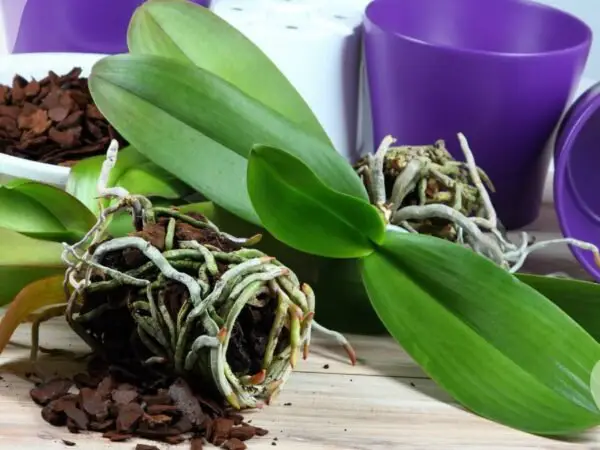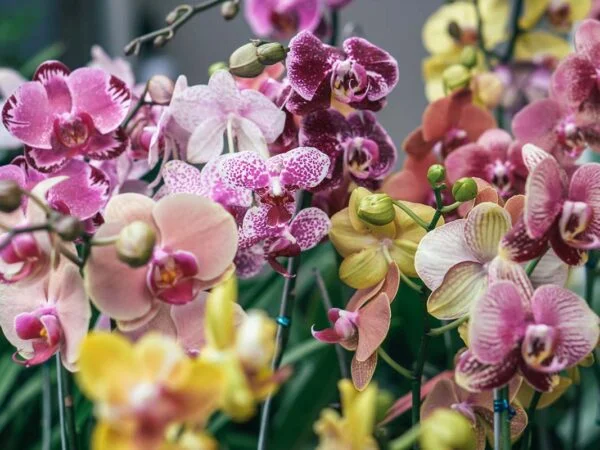Want to know the secret to getting your orchid to bloom? It's all about understanding its needs and providing the right care. While orchids may seem delicate, they are resilient plants that can thrive with the proper attention. In this guide, we will walk you through the essential steps to help your orchid bloom beautifully.
From light requirements to watering schedules, we'll cover everything you need to know to encourage your orchid to bloom. Say goodbye to wilted flowers and hello to vibrant blooms with our expert tips and tricks. Get ready to transform your orchid care routine and witness the stunning contrast in your plant's blooming cycle.
Key Takeaways
- Understand the blooming process of orchids to provide the right care and environment.
- Optimize light exposure by placing orchids in bright, indirect light for successful blooming.
- Use appropriate fertilizing techniques to support healthy growth and blooming of orchids.
- Choose an ideal location with proper humidity and temperature levels for your orchids to bloom effectively.
- Implement watering and care tips such as maintaining proper moisture levels and avoiding overwatering.
- Monitor your orchids regularly, adjust care routines as needed, and follow advanced tips to encourage blooming.
Understanding Orchid Blooming
Orchids go through various stages in their life cycle, from new orchid flowers to dormant periods. Understanding these phases is crucial for successfully getting an orchid to bloom. Dormancy plays a significant role in the blooming cycle of an orchid, affecting its overall health and vitality. Without proper dormancy, orchids may struggle to produce new blooms effectively.
Orchid Life Cycle
An orchid's life cycle consists of distinct stages, including growth, blooming, and dormancy. During the blooming stage, the plant produces new orchid flowers that are visually stunning and vibrant. However, after flowering, orchids enter a dormant phase where growth slows down, and blooming ceases. This period is essential for the plant to conserve energy and prepare for the next blooming cycle.
- Pros:
- Allows the plant to rest and recover.
- Prepares the orchid for future blooming cycles.
- Cons:
- May lead to a lack of blooms during dormancy.
- Requires proper care and attention to ensure orchid health.
Signs of Blooming Readiness
Recognizing when an orchid is ready to bloom is key to nurturing its growth and ensuring a successful blooming season. Look out for specific signs that indicate your orchid is preparing to bloom, such as changes in the leaves or roots. These subtle transformations serve as early indicators of blooming readiness. Keep an eye out for the emergence of flower spikes, which signify that blooming is just around the corner.
- Key Information:
- Changes in leaves or roots signal blooming readiness.
- Flower spikes indicate imminent blooming.
Optimizing Light Exposure
Right Light for Growth
Orchids require adequate light to thrive. To ensure healthy growth, place your orchid in a spot where it can receive indirect sunlight. This helps prevent the leaves from burning and promotes photosynthesis.
For optimal growth, position your orchid in an area with bright, filtered light. This could be near an east-facing window or behind a sheer curtain. Avoid placing orchids in direct sunlight as it can scorch their delicate leaves.
To promote healthy development, make sure your orchid gets 6-8 hours of light daily. Adjust the location based on the intensity of the light to prevent wilting or yellowing of leaves. Monitoring the plant's response to light is crucial for its overall health.
Boost Light for Blooms
Increasing light exposure can stimulate orchids to bloom. If your orchid is not blooming, try relocating it to a brighter location with more indirect sunlight. This change can trigger the flowering process by providing the necessary energy.
If natural light is insufficient, consider supplementing with artificial lighting. LED grow lights are an excellent option for enhancing light levels and encouraging blooming in orchids. These lights mimic natural sunlight and can be adjusted to meet the plant's specific needs.
Artificial lighting should be used as a supplementary source to boost blooming potential. Place the LED grow lights above the orchid at a distance that provides ample brightness without causing heat stress. Consistent exposure to artificial light can help orchids produce vibrant blooms.
Fertilizing Techniques
Encourage Blooming with Fertilizer
Fertilizers play a crucial role in promoting blooming in orchids. By providing essential nutrients, fertilizers support the flowering process. Selecting the right fertilizer is key to ensuring your orchid receives the necessary elements for blooming. Orchids require a balanced mix of nutrients to bloom successfully.
To encourage your orchid to bloom, it's important to understand how fertilizers contribute to this process. Different fertilizers contain varying levels of essential nutrients such as nitrogen, phosphorus, and potassium. These nutrients are vital for promoting flower growth and overall plant health.
- Key Points:
- Choose a fertilizer with a balanced ratio of nutrients.
- Look for fertilizers specifically formulated for orchids.
- Follow the recommended dosage instructions for optimal results.
Fertilizing Cautiously
When it comes to fertilizing your orchid, it's crucial to follow proper guidelines to avoid causing harm to the plant. Over-fertilizing can lead to nutrient imbalances and damage the roots of the orchid. Diluting the fertilizer correctly is essential to prevent negative effects on your orchid's health.
To ensure your orchid thrives, it's recommended to fertilize cautiously. By following the manufacturer's guidelines on application frequency and dosage, you can provide the necessary nutrients without overwhelming the plant. Properly diluted fertilizers help maintain a healthy balance of nutrients for your orchid.
- Key Points:
- Avoid over-fertilizing to prevent root damage.
- Dilute fertilizers according to the instructions provided.
- Monitor your orchid's response to fertilization and adjust as needed.
Ideal Location for Orchids
When it comes to indoor orchids, finding the right spot is crucial for encouraging blooming. Phalaenopsis orchids are one of the most popular orchid varieties known for their vibrant blooms. Moving your orchid to a new location can often trigger the blooming process. Consider relocating your phalaenopsis orchid to a cooler area to stimulate blooming. By exploring different spots, you can find the ideal environment that encourages your orchid to bloom. Monitor your orchid closely after moving it to observe how it responds to the new location.
Find a New Spot
- Change your orchid's location to stimulate blooming
- Explore cooler areas to trigger blooming
- Monitor your orchid after relocation for blooming responses
Lowering the temperature is another effective way to promote blooming in your orchid. Adjusting the temperature can create an environment that encourages your phalaenopsis orchid to bloom. Orchids thrive in cooler temperatures, so maintaining consistent lower temperatures can provide optimal conditions for blooming. By creating a cooler atmosphere, you can help your orchid transition into its blooming phase smoothly.
Lower Temperature for Blooms
- Adjust temperature to promote blooming
- Create a cooler environment for blooming
- Maintain lower temperatures for optimal conditions
Watering and Care Tips
Watering for Health
Proper watering is crucial for orchid health. Orchids need the right amount of water to thrive. Incorrect watering can lead to root rot, affecting the plant's ability to bloom.
Learning the correct way to water your orchid is vital for its overall well-being. Overwatering is a common mistake that can prevent blooming.
Regular Care Routines
Consistency is key when caring for your orchid. Establishing a routine helps maintain its health. Follow a regular care schedule to ensure your orchid receives the necessary attention.
Incorporate essential care practices into your routine to promote healthy growth and successful blooming.
Advanced Tips for Blooming
Repotting for Health
Repotting your orchid is essential for blooming. Knowing when and how to repot is crucial. Choose the right time and method to support blooming effectively. Repotting enhances orchid health, promoting better blooming cycles.
When repotting, look for signs like overcrowded roots or decaying media. These indicate the need for repotting. Optimal times for repotting are after flowering or when new growth appears. Use fresh orchid mix during repotting to ensure proper drainage and aeration.
Benefits of repotting include improved nutrient absorption, reduced risk of root rot, and enhanced growth potential. Repotting also helps prevent disease spread and promotes overall plant vigor.
Remove Dead Spikes
Identifying and removing dead flower spikes is crucial for orchid health. Pruning dead spikes helps maintain the plant's vitality. Promptly removing dead flower spikes prevents issues like fungal infections or pest infestations.
Inspect your orchid regularly to spot any dead spikes. Use sterilized tools to cut the spike at its base without damaging the plant. Removing dead spikes redirects energy towards new growth, encouraging future blooms.
Regularly removing dead spikes ensures optimal air circulation around the plant, reducing the risk of mold or bacterial growth. It also maintains the orchid's aesthetic appeal by keeping it tidy and healthy.
Monitoring and Adjusting Care
Watching for Stress Signs
Monitor your orchid regularly to catch any signs of stress that could impact its blooming cycle. Look out for wilting leaves, yellowing foliage, or stunted growth as these are common indicators of stress in orchids. By observing your plant closely, you can address any issues promptly to promote blooming.
Recognize common stress signals such as wrinkled leaves, which may signify dehydration, or root rot caused by overwatering. Identifying these signs early on can help prevent further damage to your orchid and encourage it to bloom successfully. Take proactive steps to provide the necessary care adjustments based on these stress indicators.
Adjusting Care as Needed
Be flexible in your care routine and willing to make changes according to how your orchid responds. If you notice suboptimal blooming conditions, consider adjusting factors like light exposure, watering frequency, or humidity levels. Tailoring your care practices to suit your orchid's preferences can significantly impact its blooming cycle.
Modify your care strategies based on the specific needs of your orchid. Each orchid species may require different care approaches, so it's essential to adapt accordingly. By understanding and responding to your plant's individual requirements, you can create an ideal environment that encourages healthy growth and abundant blooms.
Encouraging Reblooming
Reblooming Basics
To encourage your orchid to bloom again, understand the essential steps for successful reblooming. Implement proper strategies such as providing adequate light and humidity levels. Care for your orchid post-blooming by trimming old flower stalks and promoting dormancy.
When it comes to caring for your orchid post-blooming, ensure you remove old flower stalks to redirect energy towards new growth. Avoid overwatering during the dormancy period to prevent root rot. Monitor your plant's health closely to anticipate spring blooming.
- Trim old flower stalks
- Monitor plant health
- Avoid overwatering during dormancy
Timing and Techniques
Master the timing and techniques crucial for successful orchid reblooming. Fine-tune your blooming strategies based on the specific timing requirements of your orchid species. Implement proven techniques like adjusting light exposure and fertilization schedules for hearty blooms.
To maximize blooming outcomes, adjust light exposure based on your orchid's needs. Optimize fertilization schedules to provide essential nutrients for colorful flowers. Monitor environmental conditions closely to ensure optimal growth conditions.
- Adjust light exposure
- Optimize fertilization schedules
- Monitor environmental conditions
Final Remarks
By understanding the nuances of orchid care, optimizing light exposure, fertilizing correctly, choosing ideal locations, watering appropriately, and implementing advanced blooming tips, you are on the right track to witnessing your orchid bloom vibrantly. Remember to monitor and adjust your care regimen diligently to ensure your orchid's health and encourage reblooming. With these strategies in place, you are well-equipped to nurture your orchid effectively and enjoy its beautiful blooms.
Take the time to apply these insights consistently, and soon you will be rewarded with a flourishing orchid display. Your dedication to following these guidelines will not only result in a stunning orchid but also deepen your appreciation for the beauty of nature. Keep up the excellent work in caring for your orchids!
Frequently Asked Questions
How often should I water my orchid plant?
Water your orchid plant once a week during the growing season. Allow the water to drain completely to avoid root rot. In winter, reduce watering frequency to every 10-14 days.
What is the best location for my orchids to bloom?
Place your orchids in an east or west-facing window to receive indirect sunlight. Avoid direct sunlight as it can scorch the leaves. A location with good air circulation is also beneficial.
Should I fertilize my orchids during blooming season?
Yes, fertilize your orchids with a balanced fertilizer diluted to half strength every two weeks during the blooming season. This will provide essential nutrients for healthy growth and vibrant blooms.
How can I encourage my orchid to rebloom?
To encourage reblooming, trim the spike above a node after flowers fade and continue regular care routines. Provide a slight drop in temperature at night (around 10-15°F) for a few weeks to stimulate flower production.
What are some advanced tips for successful orchid blooming?
Consider using a humidity tray or humidifier to maintain optimal moisture levels. Repot your orchid if it outgrows its container, and ensure proper ventilation around the roots. Regularly inspect for pests and diseases to prevent issues that can hinder blooming.
Image Source: Paid image from CANVA





